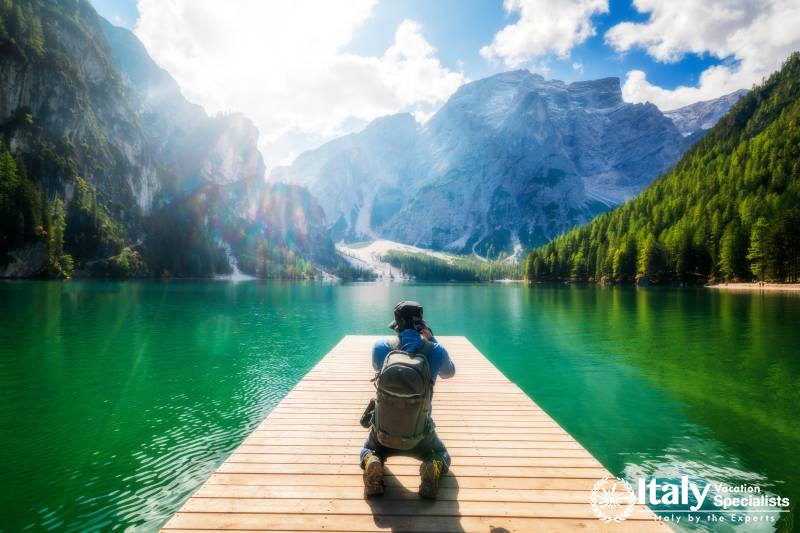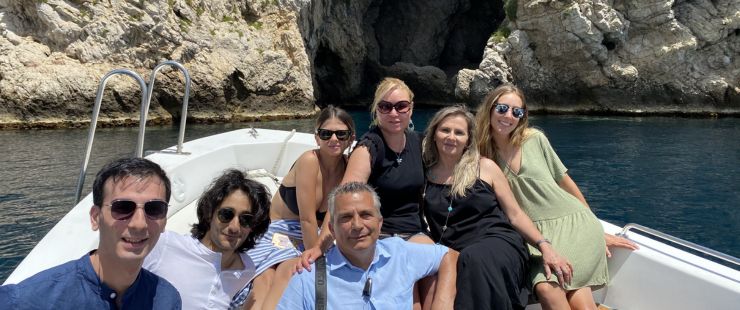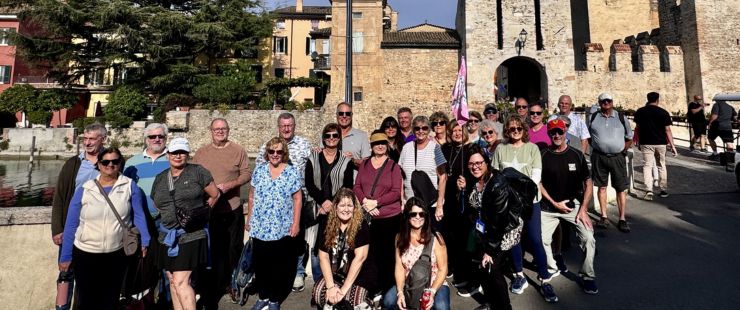The Veneto region in Italy is one of the most remarkable and romatic regions. It offers visitors a journey through the land of Palladio, Giorgione and Titian, through enchanting mountains and vine carpeted valleys, to some of Italy's most romantic cities.
A land of rolling hills, rivers, lakes and impressive architecture; Veneto is a stunning region in Italy’s north east. Extending from the UNESCO World Heritage listed Dolomites mountain range to the Adriatic Sea, it is rich in character and natural beauty.
To the west, Lago di Garda (Lake Garda) separates Veneto from the Lombardy region. At 370 square kilometres – measuring 54 kilometres long and from three to 18 kilometres wide – it is Italy’s largest lake. This majestical lake is fed by the Sarca River at the northern end and the Po River at the southern end. In Verona the lake is surrounded by beautiful little towns including Peschiera del Garda which features a gate into the town, and Torri del Benaco which is home to a picturesque castle rising up above the lake.
Verona is situated to the east of Lake Garda and famous throughout the world for being the home of Shakespeare’s tragic story of two star-crossed lovers, Romeo and Juliet. Each year, thousands of tourists flock to the 14th century Casa di Giulietta (Juliet’s house) to see the balcony where, according to legend, Romeo and Juliet are believed to have exchanged their words of love.
Aside from its links to this ill-fated love story, Verona has countless other attractions including historic castles and villas, and many impressive gardens.
The Roman Amphitheatre can be found in one of Verona’s largest squares, Piazza Brà. Constructed in the first century AD, it is the third largest remaining amphitheatre in Italy. During the summer months it plays host to many shows and concerts including renowned opera performances. Numerous bars and cafés can also be found in Piazza Brà.
In the northernmost part of Verona lies Lessinia, an area characterised by its natural beauties. This wide highland is scattered with rare plant species, picturesque towns with stone-roofed houses, forests, grasslands, vineyards, olive groves and rare fossils. The Regional Nature Reserve of Lessinia was established in 1990 to help protect the area’s natural and historical charm, and to allow tourists to easily explore Lessinia by foot or bicycle. Also in Lessinia, overlooking Lake Garda, is Mount Baldo. It is widely regarded as the garden of Europe for its rich flora and fauna and can be explored via the modern panoramic cableway, complete with rotating cabins.
Valpolicella is Verona’s viticulture capital, producing the renowned DOC wines Amarone (a dry red made from dried grapes) and Recioto (a sweet red variety). There are several winery tours available in Valpolicella, with many of these also taking in much of the area’s history and scenery.
In addition, one of Italy’s most spectacular Renaissance gardens is found in Verona. Situated across from the Adige River, Giardino Giusti features perfectly manicured hedges, fountains, grottos, cypresses, a small maze and most of its original features. Count Agostino Giusti designed the garden in the 1570s and it became open to the public in 1591. According to legend, lovers able to find each other in the garden’s maze are destined to stay together for the rest of their lives.
The Rovigo, Padua and Vicenza provinces are adjacent to Verona and can all be accessed via train or car.
Travelling to Veneto’s far south, we arrive at Rovigo in the Po Valley. The province is crossed by both the Po and Adige rivers, and features a network of canals and ancient towers. Amongst its key landmarks is a pair of leaning towers – Torre Donà, which is one of the tallest medieval towers in Italy, and Torre Mozza. Other attractions include Palazzo dell’Accademia dei Concordi which houses a library and art gallery, Palazzo Roverella, Palazzo Roncale and the Cathedral of Rovigo.
Above Rovigo is the Padua province, best known for its ancient 800 year old university and its natural thermal springs which are among the largest and most famous in Europe.
Renowned for their healing properties, Padua’s thermal baths and mud treatments have been enjoyed for many centuries. The towns Abano Terme and Montegrotto Terme are home to some of the most important thermal spas in Padua – and Italy.
Rich volcanic mud in Abano Terme and Montegrotto Terme is derived from pure mineral-rich volcanic ash, and is said to be beneficial to the skin. It is applied using a combination of heat and water therapies and believed to assist with conditions that include joint pain, muscle strain, arthritis, fractures, rheumatism, osteoporosis, gout and respiratory illness.
Hot springs in these towns can reach temperatures of up to 80°C. Many hotels feature indoor and outdoor thermal swimming pools with temperatures that hover between 30°C to 35°C.
Padua is also home to Prato della Valle. At 90,000 square metres, it is the largest square in Italy.
In Vicenza, there is an abundance of rivers, mountains and valleys combined with countless Venetian villas dating from the 16th to 18th centuries. The Altopiano di Asiago plateau in Vicenza’s north features seven communes and is characterised by enchanting forests, alpine meadows and rivers. During summer the colours of nature are mesmerising, while in winter, the area is covered by white snow.
Below Altopiano di Asiago, on the Brenta River, is the medieval town Bassano del Grappa – named after nearby mountain Monte Grappa. Its main landmark is the Alpini Bridge which is a symbol of the town. Designed by Andrea Palladio in 1569, the wooden bridge has been rebuilt several times based on its original design, including after it was almost destroyed during World War II. Two 16th century arches are at the entrance and the bridge offers great views of the town. A museum at the end of the bridge, Museo degli Alpini honours Italy’s alpine troops, with archeological artifacts, paintings and photos. Bassano del Grappa is also well known for its grappa production, a clear Italian alcoholic spirit, and its history in producing colourful ceramics.
Treviso is located to Vicenza’s east, and despite having a few similar characteristics to Venice, it has its own unique charm – with canals, rolling green hills, vineyards and olive groves aplenty. World War I and World War II left their mark on the province, however many of the buildings and affected areas have been rebuilt and restored.
City walls almost four kilometres long were built for defense during the 16th century around Treviso’s historical centre – and today, these walls still remain very much intact. Two white stone monumental gates can be found on the walls. The town is also surrounded by waterways, resulting in Treviso being affectionately known as the città d’acque (city of water).
And finally, to the north of the Veneto region is the province of Belluno, which is surrounded by the Dolomites. Listed as a UNESCO World Heritage site in 2009, the Dolomites is a mountain range in the northern Italian Alps with 18 peaks that soar to over 3000 metres. Here, there are beautiful mountain landscapes, large valleys, rocky peaks and sheer cliffs. Lakes, rivers and enticing waterfalls are also key features.
Contrasting this beautiful natural wonder is some impressive architecture including the Porta Rugo gates in Belluno’s ancient walls, the Cathedral of Belluno and the Andraz Castle that rises above a hill.
Veneto is a region rich in history – with each of its provinces showcasing their own unique character and flavour. Here, an abundance of natural wonders come together to offer an explosion of beauty. Lakes, rivers, canals, thermal baths and mountains are some of Veneto’s most important and loved features. Historical buildings and monuments can be found far and wide. It’s no secret that Venice is full of splendour, but travel just a little further and you may just discover a whole new world of surprises.
Until recently, when one thought of Veneto, one thought immediately, if not almost exclusively, of Venice, partly due to the fact that, for over eleven hundred years, Veneto was an integral part of the Serenissima's territory. Today, Veneto has established its own distinct identity and offers hospitality to numerous visitors eager to explore the many treasures of the region; from the majestic Dolomiti Mountains over which Cortina d'Ampezzo reigns supreme, to the elegant Palladian villas of Vicenza. Then there is Verona, the city of Romeo and Juliet, and home to the imposing Arena, where both important classical concerts and modern music events are performed. Veneto also boasts other splendid cities such as Treviso, Padova, Chioggia, as well as the magnificent Po delta.











































































